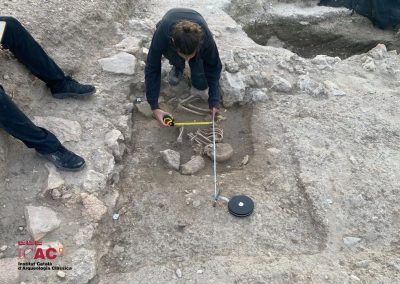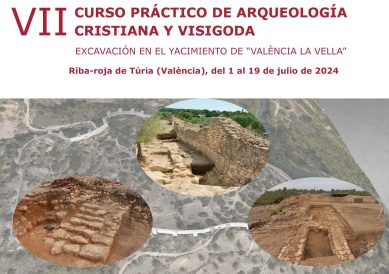
Open enrollment for the 7th Training Course on Christian and Visigoth Archaeology, run by the ICAC and the Riba-roja de Turia City Council!
The 7th Training Course on Christian and Visigoth Archaeology, which will take place from July 1 to 19, is a unique opportunity to learn about the basic methodology of archaeological excavation and analysis, but also to work on a very special site, such as that of Valencia “la Vella”.
The training program combines daily fieldwork at the site with tasks of analysis of the results, as well as various parallel activities (theoretical sessions and visits to sites in the surrounding area). The course offers training content specifically oriented toward Late Antique archaeology, its material culture, and its historical problems.
From July 1 to 19, the training course will alternate the excavation of the archaeological site of Valencia “la Vella” with hands-on tasks of washing and cataloging archaeological remains found, visits to other Late Ancient sites in the surrounding area, and some scientific talks on topics related to the Visigothic and Christian world.
Check out the provisional PROGRAMME
Practical information:
- Openings: 12 Archaeology students (undergraduate or postgraduate). There are three vacancies reserved for students of the University of Valencia (UV).
- Deadline for registrations: May 19th, 2024
- Registration fee: 100 € (including insurance, full accommodation, and meals on working days).
- Material: each student has to wear safety boots, gloves, sun protection measures, anti-mosquitoes, and bedding (including cleaning).
- This is an outdoor activity during July, in an environment with high humidity.
Deadline for applications: May 19, 2024
Download the leaflet in pdf to access the registration form
The archaeological site of Valencia «la Vella»:
Valencia “la Vella” is an archaeological site from the Visigothic period in the municipality of Riba-roja de Turia, located about 16 km from the city of Valencia. It is a walled enclave located on top of a hill in a spectacular location overlooking the River Turia, about 2 km from the Pla de Nadal palace and within the Turia River Natural Park.
Since 2016, the City Council of Riba-roja de Turia (Valencia) promotes an archaeological research and heritage conservation and dissemination project developed by the Catalan Institute of Classical Archaeology (under the direction of ICAC researcher Josep Maria Macias), with the support of the Valencia Provincial Council and the Generalitat Valenciana.
Valencia «la Vella» is an ex novo foundation that stands out for its walls that surround a river hill 20/40 m high and that are reinforced by numerous towers.
The settlement has been known since the 14th century and, partly due to its name, had been associated with the pre-Roman and Roman settlement Pallantia. Archaeological excavations in the seventies of the last century, motivated by partial destruction of the site, showed a Late Antiquity chronology.
Valencia “la Vella” was once again removed from all scientific interests for decades. Currently, it is still an unknown and nameless city. It is an archaeological site yet to be discovered, although archaeological excavations firmly confirm its value and cultural potential, and historical relevance. It is a Visigothic city built “suddenly” 16 km from Valentia, during the second half of the 6th century and dominating the Turia river waterway.
In 2016 the ICAC posted online in open access a 3D models collection of the Valencia “la Vella” site on the Sketchfab platform:
Within the framework of the research project coordinated by the ICAC, seven archaeological campaigns have been carried out at the site. The first four were integrated into the Christian and Visigothic Archeology courses, where over twenty students and graduates from around the world participated. The 2020 and 2021 campaigns followed a different dynamic due to the pandemic situation.







